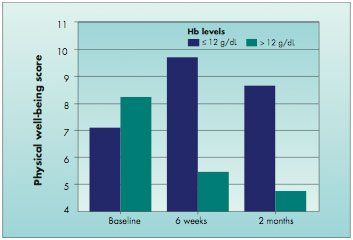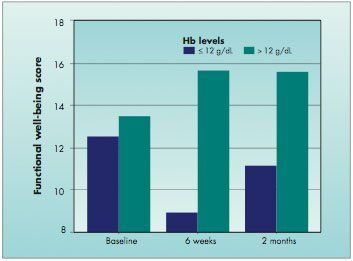Darbepoetin During RT Boosts Hb Level, With QOL Benefit
New data suggest that darbepoetin alfa (Aranesp) improves hemoglobin (Hb) levels among patients undergoing radiation therapy for various types of cancer. Higher hemoglobin levels, in turn, were associated with better measures of quality of life (QOL) and less fatigue. "We all know that anemia occurs in cancer patients undergoing radiotherapy. It might be cancer related or it might be a side effect of the cancer treatment," lead author Dosia Antonadou, MD, said at the 47th Annual Meeting of the American Society for Therapeutic Radiology and Oncology (abstract 136).
DENVERNew data suggest that darbepoetin alfa (Aranesp) improves hemoglobin (Hb) levels among patients undergoing radiation therapy for various types of cancer. Higher hemoglobin levels, in turn, were associated with better measures of quality of life (QOL) and less fatigue. "We all know that anemia occurs in cancer patients undergoing radiotherapy. It might be cancer related or it might be a side effect of the cancer treatment," lead author Dosia Antonadou, MD, said at the 47th Annual Meeting of the American Society for Therapeutic Radiology and Oncology (abstract 136). Importantly, she and her coinvestigators' note, patients who develop anemia may be less likely to respond to treatment and have a poorer prognosis.
The investigators undertook a prospective, multicenter, open-label trial to assess the impact of darbepoetin alfa on anemia and quality of life during radiation therapy, said Dr. Antonadou, a radiation oncologist at Metaxa Cancer Hospital in Greece. Patients were eligible if they were older than 18 years; had pathologically confirmed solid tumors, a good performance status, and a life expectancy of at least 6 months; and were scheduled to receive conventional external-beam radiation therapy. They could not have received a red blood cell transfusion in the preceding 12 weeks.
The patients were given total radiation doses of 50 to 60 Gy, delivered in 2-Gy fractions over 5 to 6 weeks. During radiation therapy, 150 µg of darbepoetin alfa was administered subcutaneously once weekly. In addition, all patients were given iron supplements.
The 115 evaluable patients had a mean age of 73 years. The group had slightly more women (53%) than men. The primary tumor site was most commonly the pelvis (38% of patients), followed by the breast (26%), lung (17%), head and neck (10%), and other sites (9%).
Between baseline and the end of radiation therapy (week 10), patients had an increase in mean hemoglobin level of roughly 1.7 g/dL (17%), from about 10.9 to 12.6 g/dL. "We have a difference that was statistically significant after the second week and remained so at 2 months after the treatment," Dr. Antonadou said.
In addition, throughout radiation therapy, only 3 (3%) of the patients required a red blood cell transfusion because their hemoglobin concentration fell to a level of 9 g/dL or less. "None of our patients experienced any adverse events, and this administration was well tolerated," she noted.
Quality-of-life outcomes were compared between patients who had hemoglobin concentrations that were higher (greater than 12 g/dL) and lower (12 g/dL or less) at three time points (baseline, 6 weeks, and 2 months) using the Functional Assessment of Cancer Therapy-Anemia (FACT-An).

Figure 1. Quality of life: Mean physical well-being score by hemoglobin (Hb) levels over time.

Figure 2. Quality of life: Mean functional well-being score by hemoglobin (Hb) levels over time.
Relative to patients with lower hemoglobin levels, those with higher ones had significantly better scores for physical well-being (Figure 1, lower score equals better well-being) and functional well-being (Figure 2, higher score equals better well-being), regardless of the time point of measurement. Patients with higher concentrations also tended to have better scores for social well-being and emotional well-being.
In addition, patients with higher hemoglobin concentrations had significantly better scores for fatigue at 6 weeks and 2 months, compared with patients with lower concentrations. For this measure, there was a significant interaction between group and time. "Patients with higher hemoglobin levels are getting better in terms of fatigue over time," Dr. Antonadou observed.
Commenting on the findings, she said, "Hemoglobin levels were increased significantly from baseline to the end of the radiation treatment period. It was irrespective of tumor location, stage, age, and gender." This translated into a quality-of- life benefit for patients, she concluded: "Increased hemoglobin levels were associated with better performance in physical, social, and functional well-being, as well as fatigue."
Newsletter
Stay up to date on recent advances in the multidisciplinary approach to cancer.
Oncology Peer Review On-The-Go: Cancer-Related Fatigue Outcome Measures in Integrative Oncology
September 20th 2022Authors Dori Beeler, PhD; Shelley Wang, MD, MPH; and Viraj A. Master, MD, PhD, spoke with CancerNetwork® about a review article on cancer-related fatigue published in the journal ONCOLOGY®.